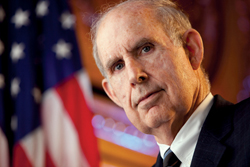A Reluctant Rebellion

Illustration by Alicia Buelow
Jon Hanson committed a despicable crime for which everyone, including the defendant, agreed he needed to be punished.
The 49-year-old Racine, Wis., funeral director, who had been secretly trading child pornography over the Internet for several years, had been caught sending four sexually explicit images of young girls to a man in Cleveland.
Much to the consternation of federal prosecutors, U.S. District Judge Lynn Adelman of Milwaukee sentenced Hanson last June to six years in prison, followed by a lifetime on parole.
Prosecutors had sought a sentence for Hanson of 17½ to 22 years in prison. Even that was on the low end of the guidelines range. They cited the size of his collection, which totaled nearly 900 images, the young age of some of the children depicted, and the fact that at least one of those images contained violent imagery. Likewise, in a chat with the Cleveland man, Hanson had made vile comments about some of the children depicted in the images.
Hanson, an otherwise law-abiding father of three, had apparently never done anything inappropriate around a child during his entire life. The defense cited Hanson’s own history of sex abuse by an older relative when he was a child, an otherwise exemplary record, his deep remorse for what he had done, and the results of a psychological evaluation by two experts who had found him to be at low risk of re-offending.
Hanson knew going into court that he was facing a mandatory minimum five-year sentence in federal prison on the transportation charge to which he had pleaded guilty, and that he would have to register as a sex offender for the rest of his life.
‘FLAWS IN THE GUIDELINES’

Judge Lynn Adelman. Photo by Mike Roemer
Judge Adelman detailed his reasons in a lengthy sentencing memorandum in which he recounted the defendant’s childhood sex abuse, his otherwise positive character and background, his efforts to rehabilitate himself after his arrest, and his remarks at sentencing that the judge said were “among the most insightful and moving” he had heard in all his years on the bench.
But Adelman devoted much of his opinion in U.S. v. Hanson to what was then a just-published critique of the child porn guidelines by an assistant federal defender in Jefferson City, Mo., whose findings have since been cited by at least five other federal judges.
That critique, “Deconstructing the Myth of Careful Study” (PDF) by Troy Stabenow, a former military prosecutor, alleges serious flaws in the guidelines—including penalties that have been increased arbitrarily and irrationally based on political demands, and “enhancement” specifics so ill-defined that they apply in almost every case.
Adelman said Stabenow’s analysis articulated many of the specific flaws in the guidelines he saw evident in the case against Hanson. “I could not conclude that under the circumstances of this case, given all of the flaws in the guidelines discussed above, that the range deserved deference,” he wrote in Hanson’s sentencing memorandum.
Adelman’s criticism goes to the heart of a much larger struggle in the federal courts over the federal sentencing guidelines that apply to computer-based child pornography offenses. Those guidelines tend to treat even first-time offenders with no history of abusing or exploiting children as seriously as murderers, rapists or child molesters.
Critics say the mandatory and recommended penalties for child porn offenses under the guidelines far exceed the seriousness of the crime committed by the typical offender who is swapping and downloading child porn online with other like-minded individuals in the presumed privacy of his own home.
Assistant U.S. Attorney Jonathan Koenig, who prosecuted Hanson, refused to discuss the case or the guidelines.
But prosecutors and activists say the proliferation of child pornography on the Internet is an insidious problem that justifies the taking of extreme measures.
It is a debate that pits polite society’s disgust and revulsion against a judge’s solemn duty to impose a penalty that serves the three main purposes of sentencing: to punish the defendant, protect the public and deter the offender from re-offending.
Child porn cases account for about 2 percent of the entire federal criminal caseload, according to the U.S. Department of Justice, but they make up one of the fastest-growing segments of the federal court docket. The number of new cases filed has grown from a few dozen annually in the late 1990s to more than 2,200 in fiscal 2008, ending Sept. 30. That latest figure represents a 33 percent increase over the 2006 fiscal year, and a doubling in the number of new cases since 2003.
The average sentence has lengthened as well, according to the U.S. Sentencing Commission. In 1997, child porn offenders (not including those involved in its production) received an average sentence of less than 21 months in prison. In 2007, the same class of offenders received an average sentence of more than 91 months, an average annual increase of more than seven months per offender and a nearly 350 percent increase over the previous decade.
But those same statistics also show that more than one-third of all child porn defendants sentenced for nonproduction-related offenses in 2007—351 out of 1,025 offenders—received sentences below the recommended guidelines. And, in the past two years alone, a small but growing number of federal judges have felt strongly enough about the guidelines to register their objections in the form of a written opinion.
A ONE-STRIKE RULE
In 2007, then-Chief U.S. District Judge Robert Holmes Bell of Grand Rapids, Mich., said he had been “troubled” and “shocked” to discover that a married 35-year-old man with no criminal record—the father of a 2-year-old girl—was facing 11¼ to 14 years for a single count of possessing child porn.
The judge gave the defendant 5½ years in prison followed by 10 years’ parole, which was later affirmed on appeal.
“This is what happens,” said Bell in U.S. v. Grossman, “when you take judging, which is a judge’s job, and you give it to a commission and say: Add mathematical calculations and come up with a presumed sentence from that.”
Last June, Chief U.S. District Judge Robert W. Pratt of Des Moines, Iowa, expressed similar reservations in U.S. v. Shipley in the sentencing of a married, 46-year-old father of two teenage girls on one count of receiving child porn.
Instead of the recommended 17½ to 20 years, he sentenced the defendant to 7½ years in prison, followed by five years’ parole, complaining that the guidelines “do not appear to be based on any sort of empirical data.” He said he had been unable to locate any particular rationale for them beyond the “general revulsion” associated with child exploitation-related offenses.
And a few weeks after Hanson was sentenced, U.S. District Judge William Griesbach of Green Bay, Wis., sentenced a 26-year-old casino worker and first-time offender to the mandatory five years, followed by a lifetime on parole in U.S. v. Ontiveros.
Jose Ontiveros testified that he had tried to delete the child porn on his computer before he even knew he was being investigated. That had no bearing on the guideline recommendation of eight to 12 years.
“Unfortunately,” says his lawyer, federal defender Krista Halla-Valdes, “the only way to get rid of what you have on your computer is to smash it with a baseball bat or burn it.”
Citing Adelman’s decision and the Stabenow study, Griesbach concluded that existing child porn guidelines “do not reflect the kind of empirical data, national experience and independent expertise” that would reflect the Sentencing Commission’s perceived institutional role.
Commission officials refused to comment on any aspect of the guidelines. The agency also issued a long list of proposed amendments to the guidelines for public comment in mid-January, none of which would substantively change the penalties for child porn offenses.

Troy Stabenow
Photo by Whitney Curtis
Stabenow says he began the study in early 2008 in an effort to rationalize the sentences that could be expected for the low-level child pornography offenders he was representing. “I was representing lots of clients in these cases. It’s a growth industry,” he says.
The problem with the guidelines, according to Stabenow and a growing chorus of critics, begins with the severity of the penalties. Possessing even one illegal image is a felony punishable by up to 10 years in prison. Receipt, transportation, distribution and production all carry a mandatory minimum five-year sentence and are punishable by up to 20 years in prison.
Some of those penalties have been increased in an effort to go after what the commission called the “most dangerous” offenders, a group it has defined as repeat sexual offenders and producers of child porn. But according to Stabenow’s analysis, nearly 80 percent of all child porn defendants in 2006 had no prior felonies of any kind, let alone a history of sexually abusing or exploiting a child. And only 5 percent of all child porn defendants in 2007 had been charged with production.
BROAD-BRUSH APPROACH
Moreover, the guidelines make no clear distinction between the offender who swaps a few images online with another offender and the mass producers and distributors who make and market such material to millions of potential customers worldwide.
The guidelines also include so-called enhancements that ratchet up potential penalties without distinction from the basic crime. For instance, an enhancement occurs when a computer is used to transmit an image—which is the way most images are exchanged; another for trading an image for “a thing of value,” which can—and usually does—mean another image. Other enhancements are based on the number of images possessed, the age of the children depicted, and on images that depict violence and sadistic or masochistic conduct.
Compounding the problem, Stabenow and other critics say, is a Justice Department policy requiring that all child porn cases be prosecuted for the most serious, readily provable offense. This means that even low-level offenders—those who strictly trade and view images for their own gratification—are often prosecuted for receipt, transportation or distribution, which carry higher penalties and mandatory minimums.
Moreover, the guidelines are predicated on the untested assumption that anyone who would access and view child porn is a potential child molester—an assumption for which, critics say, the evidence is both scant and inconclusive.
There is no published research on the odds that viewers of child porn will actually assault a child. The only data that has been done is skewed by the fact that it is based on people who have already been caught. To date, however, the available evidence suggests that access to child porn in the absence of other risk factors does not appear to strongly predict future contact offenses.
“There’s nothing very definitive when it comes to sexual disorders, especially sexual disorders involving children,” says Dr. Avak “Al” Howsepian, a psychiatrist and professor at the University of California at San Francisco’s Fresno campus who treats sexual offenders and evaluates child porn offenders awaiting sentencing. “We don’t even really know why anyone has any sort of sexual orientation or interest.”
The result is a sentencing scheme in which the typical offender “charts” at a guideline range that automatically exceeds the statutory maximum, even when there is a full acceptance of responsibility, complete cooperation with law enforcement officials, little or no threat of physical harm to any children and no criminal history.
Racine defense lawyer Mark Richards, who has represented several child porn offenders, including Hanson, says the guidelines operate like a rocket ride into the sentencing stratosphere.
“They break down the basic offense into all these tiny little increments that almost repeat one another and then come up with this astronomical number,” he says. “You can get a lower score for killing somebody than for downloading child porn.”
Stabenow says most people would probably agree that swapping child porn is a serious crime that warrants punishment. But most would be hard-pressed to explain why a child porn offender deserves to be punished more severely than somebody who uses the Internet to try to entice a child into having sex.
Under the guidelines, a person who only views and downloads child porn online faces a recommended sentence similar to Hanson’s: 210 to 262 months. A hypothetical molester who uses the Internet to persuade a minor from another state to meet with the intent to engage in sex would face sentencing guidelines of 87 to 108 months, with a 10-year mandatory minimum.
An actual offender, Joe J. Champion of Granite City, Ill.—who paid the mother of a 9-year-old girl to hold her daughter down while he raped her twice a week for two years—got a recommendation, under the guidelines, of 151 to 188 months. Champion’s sentencing was discussed in U.S. v. Kane, the case of his co-conspirator.
Stabenow says the child porn guidelines, in effect, punish for presumed future behavior. Moreover, they equate the titillation of witnessing an illegal act with its actual commission. If that were universally true, he says, there would be greater evidence in popular culture.
“People who watch movies like Saw and Friday the 13th are being titillated by the act of torture and murder,” says Stabenow. “That doesn’t mean that they’re going to go out and commit torture and murder.”
Ohio State University law professor Doug Berman, an expert on sentencing, says that Stabenow’s analysis has confirmed complaints he has seen and heard about the operation of the child porn guidelines.
Berman, who writes an influential blog on sentencing issues, says the huge disparity in federal child porn sentences in recent years is due to differences in the exercise of prosecutorial discretion. “One would be hard-pressed to find any consistent set of policies or principles that would explain why some child porn offenders face decades in prison while others face years—and still others face little or no prison time at all,” he says.
Part of the paradox is that the least dangerous child porn offenders are often the easiest to catch and convict. They are often surprised at how aggressively anti-child-porn laws are enforced and how serious the consequences can be for those who get caught.
“They know what they’re doing is morally wrong,” says Studio City, Calif., defense lawyer Alan Baum, who says he has represented dozens of child porn offenders, “but they have no idea that it’s a crime, let alone a federal crime punishable by five or 10 or 20 years in prison.”
Baum says some of the prosecutors he has dealt with have been willing to plea-bargain a child porn charge down to a lesser offense in a particularly compelling case. But others won’t budge from department policy, no matter what the circumstances.
THE INTERNET ISSUE
Prosecutors argue that child pornography has spun out of control since the advent of the Internet. They point out that real children are harmed, sometimes grievously, in the making of such material. They contend that the victim is revictimized every time an existing image is viewed, that an image in cyberspace will circulate forever—continuing to victimize the subject for the rest of his or her life.
Timothy W. Funnell, an assistant U.S. attorney in Green Bay, Wis., who has prosecuted several child porn offenders, including Ontiveros, says he doesn’t understand how anybody could characterize the guidelines as being unfair or unjust. He says the guidelines are designed to take into account all of the aggravating and mitigating factors that come into play in a particular case. And, if everybody does his or her job and follows the law, the result should be a just one.
Funnell also says he thinks the public misperceives the kinds of images for which child porn offenders are being prosecuted. They may think of a few innocuous photographs of naked children sitting in a bathtub, but the reality is much darker.
“We’re usually talking about hundreds if not thousands of images of some of the most deviant and disturbing subject matter imaginable,” he says.
Drew Oosterbaan, chief of the Justice Department’s Child Exploitation and Obscenity Section, says the DOJ’s policy of prosecuting all cases for the most serious, readily provable offense is not peculiar to child porn prosecutions. The policy—commonly known as “stacking”—applies to all federal prosecutions, be they for terrorism or public corruption.
“It’s the only way to ensure that all cases are treated alike,” he says.
Funnell concedes that the typical penalties for child porn offenses tend to be more severe than those for contact offenses. But if that’s the case, he says, the solution is to increase the penalties for contact offenses, not to lower the penalties for child porn crimes.
Moreover, mitigating circumstances—such as those argued by Ontiveros—prove less than meets the eye. Ontiveros offered no proof other than his word that he actually tried to delete the porn in his possession. And he twice lied to investigators about the extent of his involvement in child porn before admitting he had actively searched for it, downloaded it and stored it on DVDs.

Ernie Allen. Photo by Ron Aira
“This is not a victimless crime,” says Ernie Allen, president and co-founder of the National Center for Missing and Exploited Children, bristling at the suggestion that people who access and trade child porn online are being punished too harshly. “These are serious crimes and they ought to be treated seriously.”
Allen says those viewing and trading in child porn are not going to be satisfied just looking at pictures. And some may even be motivated to create their own to gain entree to certain file-sharing circles whose members are required to provide images in order to receive them.
Nor is he willing to concede that those who access and download child porn pose no threat to actual children.
Allen cites a controversial study involving 155 convicted child porn offenders at one federal prison who were asked whether they had ever molested a child. At the start of the study, only 40 of the men (26 percent) had known histories of sexual abuse involving children. After treatment, however, 132 of them (85 percent) acknowledged having committed a sexual offense involving children, some of them many times over.
Allen concedes the point of controversy: The study was withdrawn before peer review because of questions about the authenticity of the prisoner responses. But some child porn offenders will go on to molest a child, he argues. And if a few offenders have to be severely punished to deter others, he reasons, so be it. “Maybe it will make others think twice about accessing this stuff in the first place.”
Hanson didn’t respond to a letter requesting comment from him in prison. But Ontiveros, who is an inmate at the same Pennsylvania prison, responded in writing.
ONE INMATE EXPLAINS
Ontiveros says his interest in child porn began with an addiction to adult pornography and grew from there. He also says he realized that his interest in child pornography was a problem weeks before he was first contacted by the FBI. “I wasn’t missing work and it wasn’t detrimental to my life, but in general it was having a negative impact on me morally,” he wrote. So he started deleting his collection, he says, beginning with the illegal material.
Still, Ontiveros says he has never molested a child and does not believe he is capable of doing so. And while he does not condone the production or possession of child porn, he thinks the penalties are extreme.
“I myself have never sold drugs, physically harmed someone with the intent to injure them, nor am I a career criminal by any stretch of the imagination,” he wrote. “Yet, for five years I will be incarcerated for the possession of images which I attempted to get rid of.”
Allen talks hopefully about a promising new technology that could be used to block the transmission of child porn based on its “hash value,” or unique digital signature. But even he admits that the technology, which is still in the testing phase, won’t eliminate online distribution of child porn.
In the meantime, the debate over the merits of the child porn guidelines in the federal courts goes on.
In December, federal judges in Iowa and New Jersey issued below-guidelines sentences for child porn offenders, citing controversy over their fairness, in U.S. v. Johnson and U.S. v. Grober. And in January, Judge Gilbert S. Merritt of the 6th U.S. Circuit Court of Appeals at Cincinnati wrote an unusually pointed dissent to a panel’s affirmance of the 17½-year sentence for child porn given to a 65-year-old Cleveland-area man with serious health problems.
Merritt said the federal legal system had “lost it bearings” on the subject of computer-based child pornography and likened the treatment of offenders to the “witchcraft trials and burnings” of several centuries ago.
“He is a 65-year-old, psychologically disabled former minister with Type 1 diabetes with many complications,” Merritt wrote in U.S. v. Paull. “How could this sentence be ‘not greater than necessary’ to punish this crime?”



